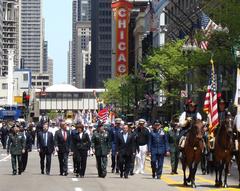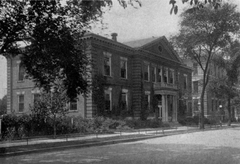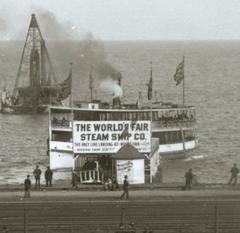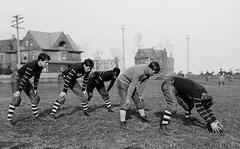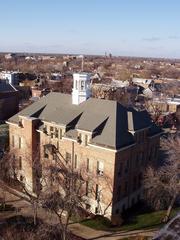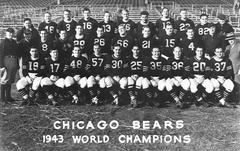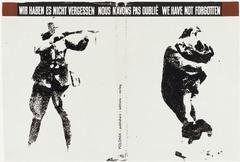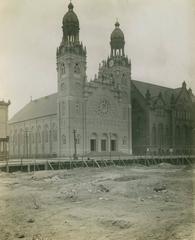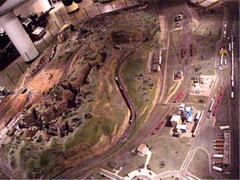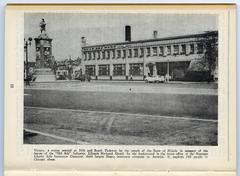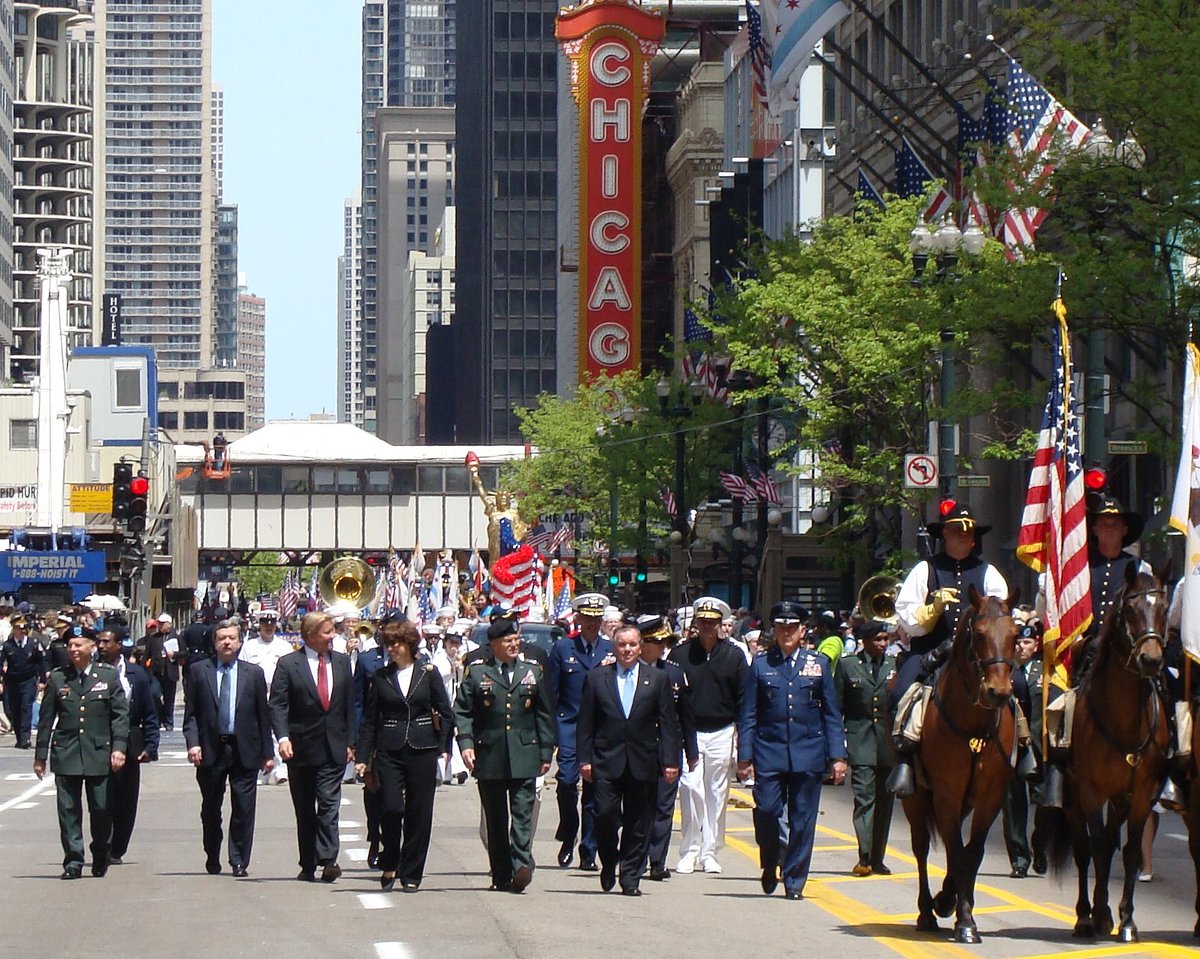
शिकागो, संयुक्त राज्य अमेरिका में स्टेट/लेक का दौरा करने के लिए एक व्यापक गाइड: इतिहास, महत्व, आगंतुक युक्तियाँ, और एक यादगार अनुभव के लिए पर्यटकों को जानने की आवश्यकता है
तिथि: 15/06/2025
परिचय: स्टेट/लेक स्टेशन की खोज करें—शिकागो का ऐतिहासिक शहरी प्रवेश द्वार
डाउनटाउन शिकागो के लूप में स्टेट स्ट्रीट और लेक स्ट्रीट के व्यस्त चौराहे के ऊपर स्थित, स्टेट/लेक स्टेशन सिर्फ एक पारगमन केंद्र से कहीं अधिक है—यह शिकागो के विकास का एक जीवंत प्रमाण है। प्रतिष्ठित शिकागो ‘एल’ के हिस्से के रूप में 1895 में अपने उद्घाटन के बाद से, इस एलिवेटेड स्टेशन ने निवासियों और आगंतुकों को शहर के वाणिज्यिक, सांस्कृतिक और वास्तुशिल्प हृदय से जोड़ने वाली एक महत्वपूर्ण धमनी के रूप में कार्य किया है (Chicago-L.org; विकिपीडिया)। आज, स्टेट/लेक पांच सीटीए रेल लाइनों (ब्राउन, ग्रीन, ऑरेंज, पिंक, पर्पल) तक सीधी पहुंच प्रदान करता है, और मिलेनियम पार्क, शिकागो थिएटर और आर्ट इंस्टीट्यूट ऑफ शिकागो जैसे प्रमुख गंतव्यों के करीब स्थित है।
19वीं सदी के उत्तरार्ध के वास्तुशिल्प आकर्षण और आधुनिक सुविधाओं—जिसमें एक प्रोग्रामेबल लाइट कर्टन वॉल और नियोजित एक्सेसिबिलिटी अपग्रेड शामिल हैं—को मिश्रित करते हुए, स्टेट/लेक संरक्षण और नवाचार की शिकागो की भावना का प्रतीक बना हुआ है (SOM)। 24/7 सेवा, वेंट्रा ऐप के माध्यम से निर्बाध टिकटिंग, और शहरी हरे-भरे स्थानों और खरीदारी गलियारों से जुड़ने के साथ, स्टेशन शिकागो के जीवंत डाउनटाउन का पता लगाने के लिए एकदम सही लॉन्चिंग पॉइंट है (CTA वेबसाइट; टाइमआउट शिकागो)।
यह गाइड स्टेट/लेक के इतिहास, परिचालन विवरण, आगामी आधुनिकीकरण, और आस-पास के आकर्षणों—जिसमें अवश्य देखे जाने वाले शिकागो वाटर टावर भी शामिल हैं—के बारे में विस्तृत जानकारी प्रस्तुत करता है, ताकि यह सुनिश्चित हो सके कि आप इस गतिशील शहरी केंद्र में अपनी यात्रा का अधिकतम लाभ उठाएं।
विषय-सूची
- प्रारंभिक शहरी विकास और स्टेट/लेक स्टेशन का जन्म
- एलिवेटेड रेल का उदय और लूप में स्टेशन की भूमिका
- वास्तुशिल्प विकास और ऐतिहासिक महत्व
- आगंतुक घंटे, टिकट और पहुंच
- यात्रा युक्तियाँ और आस-पास के आकर्षण
- शिकागो के विकास के प्रतीक के रूप में स्टेट/लेक
- आधुनिकीकरण और संरक्षण: स्टेट/लेक का भविष्य
- शिकागो के सामाजिक और सांस्कृतिक ताने-बाने में स्टेट/लेक
- ऐतिहासिक समयरेखा और मुख्य मील के पत्थर
- ऐतिहासिक विकास: उत्पत्ति से लेकर वर्तमान दिन तक
- वर्तमान दिन का महत्व, संचालन और आगंतुक अंतर्दृष्टि
- आधुनिकीकरण योजनाएँ: पुनर्विकास और प्रभाव
- व्यावहारिक यात्री जानकारी
- स्टेट/लेक से शिकागो की खोज: आकर्षण, भोजन और कार्यक्रम
- शिकागो वाटर टावर: आगंतुक गाइड
- सारांश और अंतिम युक्तियाँ
प्रारंभिक शहरी विकास और स्टेट/लेक स्टेशन का जन्म
स्टेट/लेक की कहानी शिकागो के विस्फोटक 19वीं सदी के विकास के साथ शुरू होती है। व्यापार और उद्योग के एक प्रमुख चौराहे पर स्थित, भविष्य का लूप जिला मूल रूप से देशी अमेरिकी जनजातियों द्वारा बसा हुआ था, जो शिकागो नदी और मिशिगन झील का लाभ उठा रहे थे (ब्रिटानिका; History.com)। 1833 में शिकागो की स्थापना के बाद, इलिनोइस और मिशिगन नहर जैसे बुनियादी ढांचे के मील के पत्थर ने शहर को एक परिवहन केंद्र के रूप में स्थापित किया, जिससे लूप तेजी से शिकागो का वाणिज्यिक और सांस्कृतिक केंद्र बन गया।
1800 के दशक के अंत तक, स्टेट स्ट्रीट एक हलचल भरा खुदरा और मनोरंजन गलियारा बन गया था, और जैसे-जैसे शिकागो की आबादी बढ़ी, कुशल जन पारगमन की आवश्यकता महत्वपूर्ण हो गई (Chicago.gov)।
एलिवेटेड रेल का उदय और स्टेट/लेक की भूमिका
अभूतपूर्व पारगमन मांगों को पूरा करने के लिए, शहर ने एलिवेटेड “एल” प्रणाली का निर्माण किया। स्टेट/लेक स्टेशन 22 सितंबर, 1895 को लेक स्ट्रीट एलिवेटेड रेलरोड के नव-निर्मित यूनियन लूप में विस्तार के हिस्से के रूप में खुला (विकिपीडिया; Chicago-L.org)। उस समय के इंजीनियरिंग के चमत्कार—एलिवेटेड ट्रैक—ने शहर के केंद्र तक कुशल आवागमन को सक्षम किया, जो यात्रियों को थिएटर, डिपार्टमेंट स्टोर और व्यापार कार्यालयों से जोड़ता था। स्टेशन की मूल सजावटी रेलिंग और चंदवा, जिनमें से कुछ आज भी मौजूद हैं, इसकी ऐतिहासिक जड़ों का प्रमाण हैं (Chicago-L.org)।
वास्तुशिल्प विकास और ऐतिहासिक महत्व
स्टेट/लेक स्टेशन की वास्तुकला शिकागो की पुनर्कल्पना की विरासत को दर्शाती है। हालांकि इसका मूल हाउस मामूली था, दशकों से उन्नयन ने तकनीकी सुधारों के साथ ऐतिहासिक संरक्षण को संतुलित किया है। उल्लेखनीय विशेषताओं में 2008 की बाहरी कर्टन वॉल शामिल है जिसमें प्रोग्रामेबल लाइटिंग है, जो शहर के कार्यक्रमों और छुट्टियों का जश्न मनाती है (Chicago-L.org)। महान शिकागो फायर के बाद शहरी नवीनीकरण और उसके प्रभाव के बावजूद, स्टेट/लेक लूप के केंद्र में एक प्रमुख मील का पत्थर बना हुआ है (लूप शिकागो)।
आगंतुक घंटे, टिकट और पहुंच
- घंटे: स्टेट/लेक 24 घंटे, सप्ताह के सातों दिन संचालित होता है।
- टिकट: वेंट्रा ऐप, स्टेशन कियोस्क, या अधिकृत खुदरा विक्रेताओं के माध्यम से किराए खरीदें। नवीनतम मूल्य निर्धारण के लिए, CTA वेबसाइट देखें।
- पहुंच: वर्तमान में सीमित होने के बावजूद, लिफ्ट और रैंप के साथ पूर्ण ADA अनुपालन सुनिश्चित करने के लिए एक आधुनिकीकरण परियोजना चल रही है (SOM)।
यात्रा युक्तियाँ और आस-पास के आकर्षण
- वहाँ कैसे पहुँचें: स्टेट/लेक पांच सीटीए रेल लाइनों—ब्राउन, ग्रीन, ऑरेंज, पिंक, और पर्पल—द्वारा सेवित है (विकिपीडिया)।
- आस-पास: शिकागो थिएटर, मिलेनियम पार्क, आर्ट इंस्टीट्यूट, और स्टेट स्ट्रीट शॉपिंग के लिए पैदल चलें।
- सुरक्षा: व्यस्त समय के दौरान भीड़ के लिए योजना बनाएं; सामान सुरक्षित रखें।
शिकागो के विकास में स्टेट/लेक और लूप
‘एल’ ट्रैक के गोलाकार मार्ग के नाम पर रखा गया लूप, शिकागो के एक महानगर में परिवर्तन का प्रतीक है (स्मिथसोनियन पत्रिका)। स्टेट स्ट्रीट, वाणिज्य और मनोरंजन का पर्याय, स्टेट/लेक के प्लेटफार्मों से शहर की विकसित वास्तुकला के शानदार दृश्य प्रस्तुत करता है (लूप शिकागो)।
आधुनिकीकरण और संरक्षण: स्टेट/लेक का भविष्य
2021 में, शिकागो और सीटीए ने स्टेट/लेक को एक पूरी तरह से सुलभ, आधुनिक पारगमन केंद्र में बदलने के लिए $180 मिलियन की परियोजना की घोषणा की, जबकि ऐतिहासिक तत्वों को संरक्षित रखा गया (SOM)। नियोजित उन्नयन में एक ग्लास चंदवा, चौड़े प्लेटफार्म, और सार्वजनिक बालकनी शामिल हैं। धन संघीय, राज्य और स्थानीय स्रोतों से प्रदान किया जाता है, जिसमें संघीय कंजेशन मिटिगेशन और वायु गुणवत्ता कार्यक्रम से $119 मिलियन भी शामिल है (Chicago-L.org)।
शिकागो के सामाजिक और सांस्कृतिक ताने-बाने में स्टेट/लेक
पारगमन से परे, स्टेट/लेक शिकागो की विविधता और गतिशीलता का प्रतीक है। 2019 में, इसने 3.7 मिलियन से अधिक वार्षिक प्रविष्टियाँ देखीं (लूप शिकागो)। ऐतिहासिक आकर्षण और आधुनिक सुविधा का इसका मिश्रण इसे एक महत्वपूर्ण शहरी संपत्ति बनाता है।
ऐतिहासिक समयरेखा और मुख्य मील के पत्थर
- 1895: लेक स्ट्रीट एलिवेटेड रेलरोड के साथ स्टेशन खुला (विकिपीडिया)।
- 1900s: लूप एक वाणिज्यिक केंद्र के रूप में फलता-फूलता है (Bygonely)।
- 1967: आसान स्थानान्तरण और आधुनिकीकरण के लिए एस्केलेटर जोड़े गए (Chicago-L.org)।
- 2008: प्रोग्रामेबल कर्टन वॉल स्थापित।
- 2021–वर्तमान: व्यापक आधुनिकीकरण परियोजना चल रही है (SOM)।
ऐतिहासिक विकास: उत्पत्ति से लेकर वर्तमान दिन तक
उत्पत्ति और प्रारंभिक वर्ष (1895–1940s)
स्टेट/लेक शिकागो के सबसे पुराने ‘एल’ स्टेशनों में से एक है, जो 1895 में खुला और तेजी से रैपिड ट्रांजिट नेटवर्क में एक प्रमुख नोड बन गया (chicago.gov)। इसके मूल लकड़ी के प्लेटफार्म और चंदवा उस युग की वास्तुशिल्प शैली को दर्शाते थे।
20वीं सदी के मध्य के विकास
स्टेशन ने मूल कास्ट-आयरन पोस्ट और रेलिंग को संरक्षित करते हुए प्लेटफार्मों, साइनेज और प्रकाश व्यवस्था में उन्नयन के साथ शहरी विकास के अनुकूल बनाया (chicago-l.org)।
20वीं सदी के उत्तरार्ध का नवीनीकरण
आधुनिक सुधारों में आसान स्थानान्तरण के लिए टर्नस्टाइल और डिजिटल सूचना पैनल शामिल थे। फिर भी, संकीर्ण प्लेटफार्मों और लिफ्टों की कमी चुनौतियां बनी रहीं। 2019 तक, यह लूप का दूसरा सबसे व्यस्त स्टेशन था (chicago.gov)।
वर्तमान दिन का महत्व, संचालन और आगंतुक अंतर्दृष्टि
सीटीए नेटवर्क में केंद्रीय भूमिका
स्टेट/लेक पांच प्रमुख लाइनों को जोड़ता है और मिलेनियम पार्क, शिकागो थिएटर, और आर्ट इंस्टीट्यूट से पैदल दूरी के भीतर है। ट्रेनें अक्सर चलती हैं, जिसमें वास्तविक समय अपडेट ऑनलाइन उपलब्ध होते हैं (unmissabletrips.com)।
पहुंच और ग्राहक अनुभव
हालांकि ऐतिहासिक तत्व चरित्र जोड़ते हैं, स्टेशन की वर्तमान लिफ्टों की कमी को आधुनिकीकरण प्रयासों द्वारा संबोधित किया जा रहा है (chicago.gov)। सबसे सहज अनुभव के लिए वेंट्रा कार्ड या संपर्क रहित भुगतान का उपयोग करें।
आगंतुक युक्तियाँ
- प्लेटफार्म संकेतों का सावधानीपूर्वक पालन करें।
- व्यस्त समय सबसे व्यस्त होता है; ऑफ-पीक यात्रा अधिक आरामदायक होती है।
- शिकागो थिएटर और मिलेनियम पार्क जैसे आकर्षण केवल कुछ कदम दूर हैं।
आधुनिकीकरण योजनाएँ: पुनर्विकास और प्रभाव
ट्रांससिस्टम्स और एसओएम के नेतृत्व में एक पूर्ण पुनर्निर्माण की योजना है (chicago.gov)।
मुख्य विशेषताएं:
- दोहरी चौड़ाई वाले प्लेटफार्म
- पूर्ण ADA अनुपालन के लिए चार लिफ्ट (प्रत्येक कोने पर एक) (chi.streetsblog.org)
- ग्लास चंदवा और सुंदर बालकनी
- एक प्रत्यक्ष, बिना सीढ़ियों वाले रेड लाइन ट्रांसफर सहित बेहतर कनेक्टिविटी
समयरेखा और धन: $180 मिलियन का अनुमान, जिसमें निर्माण जल्द ही शुरू होने की उम्मीद है, अंतिम धन और पर्यावरण समीक्षा के बाद (chicago-l.org; reddit.com)।
प्रभाव: नया स्टेट/लेक पहुंच, सुरक्षा और सवार अनुभव के लिए एक बेंचमार्क स्थापित करेगा।
व्यावहारिक यात्री जानकारी
- स्थान: स्टेट और लेक, शिकागो लूप
- सेवाकृत लाइनें: ब्राउन, ग्रीन, ऑरेंज, पिंक, पर्पल
- संचालन घंटे: 24/7; वास्तविक समय अपडेट के लिए CTA शेड्यूल देखें
- किराया: $2.50 एकल सवारी; विभिन्न पास विकल्प (unmissabletrips.com)
- पहुंच: प्रमुख उन्नयन जल्द ही होने वाले हैं
- आस-पास: शिकागो थिएटर, मिलेनियम पार्क, आर्ट इंस्टीट्यूट, खरीदारी
स्टेट/लेक: शिकागो के शीर्ष आकर्षणों का प्रवेश द्वार
स्टेट/लेक आपका शहरी लॉन्चपैड क्यों है
पांच ‘एल’ लाइनों से जुड़ा और लूप में स्थित, स्टेट/लेक शिकागो के मुख्य आकर्षणों का पता लगाने के लिए अद्वितीय सुविधा प्रदान करता है (शहरीकृत शिकागो)। यह मिलेनियम पार्क, आर्ट इंस्टीट्यूट, और थिएटर जिले की यात्राओं के लिए आदर्श प्रारंभिक बिंदु है।
आउटडोर स्पेस और पारिवारिक गंतव्य
- ग्रांट पार्क और बकिंघम फाउंटेन: 12 मिनट की पैदल दूरी, प्रमुख त्योहारों का स्थल (टाइमआउट शिकागो)
- लेकफ्रंट ट्रेल: चलने, साइकिल चलाने और झील के दृश्यों के लिए पहुंच (सीक्रेट शिकागो)
- मैगी डेली पार्क: आस-पास परिवार के अनुकूल मनोरंजन
- नेवी पियर: मनोरंजन और नाव टूर, थोड़ी दूर की सवारी (टाइमआउट शिकागो)
- लिंकन पार्क ज़ू: मुफ्त प्रवेश, ‘एल’ के माध्यम से पहुँचा जा सकता है
भोजन, नाइटलाइफ़ और कार्यक्रम
डीप-डिश पिज्जा से लेकर फाइन डाइनिंग तक, लूप में एक पाक स्पेक्ट्रम है। थिएटर डिस्ट्रिक्ट और रिवरवॉक नाइटलाइफ़ और लाइव मनोरंजन प्रदान करते हैं (टाइमआउट शिकागो)। ग्रांट पार्क, मिलेनियम पार्क, और आस-पास के स्थल पूरे वर्ष त्योहारों और संगीत समारोहों की मेजबानी करते हैं (चूज़ शिकागो)।
शिकागो वाटर टावर: आवश्यक आगंतुक गाइड
अवलोकन
शिकागो की सहनशक्ति का एक स्थायी प्रतीक, शिकागो वाटर टावर—1869 में निर्मित और विलियम डब्ल्यू. बॉयिंगटन द्वारा डिजाइन किया गया—महान शिकागो फायर से बच गया और अब मैग्निफिसेंट माइल के साथ एक गैलरी और आगंतुक केंद्र के रूप में खड़ा है।
घंटे, टिकट और टूर
- दैनिक खुला: 10 AM–6 PM
- प्रवेश: नि:शुल्क; विशेष प्रदर्शन भिन्न हो सकते हैं (चूज़ शिकागो)
- टूर: कई पैदल टूर वाटर टावर को शामिल करते हैं (निकोलेट द नोमैड)
वहाँ कैसे पहुँचें
- ‘एल’ को स्टेट/लेक तक ले जाएं, फिर थोड़ी बस की सवारी या उत्तर की ओर 15-20 मिनट की पैदल दूरी तय करें (गणित)
- डिवी बाइक और पैदल चलने योग्य मार्ग उपलब्ध हैं
पहुंच और सुविधाएं
गतिशीलता की जरूरतों वाले आगंतुकों के लिए सुलभ; आस-पास के शौचालय और आगंतुक केंद्र उपलब्ध हैं (गणित; शिकागो आगंतुक केंद्र)।
सुरक्षा और युक्तियाँ
डाउनटाउन शिकागो आम तौर पर दिन के उजाले में सुरक्षित है। चलने के लिए आरामदायक कपड़े पहनें और मौसम की जाँच करें (द ब्रोक बैकपैकर; द सैवी ग्लोबट्रॉटर)।
सारांश और अंतिम युक्तियाँ
स्टेट/लेक स्टेशन सिर्फ एक पारगमन पड़ाव से कहीं अधिक है—यह शिकागो के सर्वश्रेष्ठ, ऐतिहासिक स्थलों से लेकर आधुनिक सुविधाओं तक का प्रवेश द्वार है (Chicago-L.org; Chicago.gov)। क्षितिज पर एक परिवर्तनकारी आधुनिकीकरण परियोजना और शहर के आकर्षणों तक बेजोड़ पहुंच के साथ, स्टेट/लेक किसी भी शिकागो साहसिक कार्य के लिए आदर्श शुरुआती बिंदु है।
एक निर्बाध यात्रा के लिए:
- किराए के लिए वेंट्रा कार्ड का उपयोग करें
- वास्तविक समय अपडेट और यात्रा युक्तियों के लिए ऑडिएला ऐप डाउनलोड करें
- आस-पास वाटर टावर और अन्य ऐतिहासिक स्थलों का अन्वेषण करें
इतिहास, नवाचार और कनेक्टिविटी के अपने मिश्रण के साथ, स्टेट/लेक स्टेशन हर शिकागो यात्रा को समृद्ध और अधिक यादगार बनाता है (CTA वेबसाइट)।
स्रोत और अतिरिक्त पठन
- स्टेट/लेक स्टेशन - विकिपीडिया, 2025, विकिपीडिया योगदानकर्ता
- स्टेट/लेक स्टेशन शिकागो: आगंतुक घंटे, टिकट और ऐतिहासिक अंतर्दृष्टि, 2025, शिकागो-एल.ऑर्ग
- स्टेट/लेक सीटीए ‘एल’ स्टेशन: अतीत, वर्तमान और भविष्य, 2025, शिकागो.गॉव
- स्टेट/लेक स्टेशन: शिकागो के शीर्ष आकर्षणों और पारगमन हब गाइड के लिए आपका प्रवेश द्वार, 2025, टाइमआउट शिकागो
- शिकागो वाटर टावर के दौरे के लिए व्यावहारिक आगंतुक युक्तियाँ: घंटे, टिकट और अंदरूनी मार्गदर्शन, 2025, चूज़ शिकागो
- स्मिथसोनियन पत्रिका: शिकागो कैसे बदला, 2025
- सीटीए किराया और टिकटिंग, 2025, शिकागो ट्रांजिट अथॉरिटी
- ऑडिएला ऐप - वास्तविक समय पारगमन अपडेट, 2025
- शिकागो ऐतिहासिक स्थल गाइड, 2025, शहरीकृत शिकागो
ऑडिएला2024{“State/Lake Station Chicago: Visiting Hours, Tickets & Historical Insights”: ”## State/Lake Station Chicago: Visiting Hours, Tickets & Historical Insights\n\n### Early Urban Development and the Birth of State/Lake Station\n\nThe State/Lake intersection is at the heart of Chicago’s Loop, a district born from the city’s explosive 19th-century growth. Chicago’s strategic location—where the Chicago River meets Lake Michigan—made it a natural hub for trade, transportation, and industry (Britannica). The area that would become the Loop, eventually hosting the State/Lake station, was originally home to Native American tribes such as the Miami, Sauk, Fox, and Potawatomi, who utilized the river and lake for sustenance and trade (History.com).\n\nChicago’s formal founding in 1833 and incorporation in 1837 marked the start of rapid urban transformation. The Illinois and Michigan Canal (1840s), connecting the Great Lakes to the Mississippi River, accelerated Chicago’s rise as a transportation powerhouse (Britannica). By the late 19th century, the Loop had become the city’s commercial and cultural core, with State Street turning into a bustling retail and entertainment corridor.\n\n### The Rise of Elevated Rail and the State/Lake Station\n\nWith Chicago’s population soaring—from just over 4,000 in 1837 to more than 1.7 million by 1900—the need for efficient urban transportation became critical (Chicago.gov). The solution was the construction of the elevated railway system, known as the “L.” State/Lake station opened on September 22, 1895, as part of the Lake Street Elevated Railroad’s extension into the newly completed Union Loop (Wikipedia; Chicago-L.org).\n\nThe Loop’s elevated tracks, including those at State/Lake, were engineering marvels designed to move large numbers of people efficiently through downtown. The station quickly became a vital gateway to theaters, department stores, and business offices. Its original design featured decorative railings and canopies, some of which remain today, making it the last station on the State Street leg to retain significant 1895 architectural elements (Chicago-L.org).\n\n### Architectural Evolution and Historical Significance\n\nState/Lake’s architectural journey mirrors Chicago’s narrative of innovation and reinvention. The original station house was modest but underwent numerous modifications over the decades to accommodate growing ridership and safety standards. The exterior curtain wall, installed in 2008, features programmable lighting that celebrates holidays and city events, blending historic charm with modern flair (Chicago-L.org).\n\nDespite the Great Chicago Fire of 1871 and urban renewal projects, State/Lake has remained a constant in the city’s changing landscape. Its proximity to landmarks like the Chicago Theatre and the bustling State Street shopping district cements its role as a transportation hub and cultural touchstone (Loop Chicago).\n\n### Visiting Hours, Tickets, and Accessibility\n\nVisiting Hours: State/Lake station operates 24 hours a day, seven days a week, providing continuous access to Chicago’s transit network.\n\nTickets and Fares: Visitors can purchase tickets and passes through the Ventra app, at vending machines within the station, or at authorized retailers. Fares vary depending on the route and time of day. For up-to-date fare information, visit the CTA website.\n\nAccessibility: The station is undergoing modernization to become fully ADA accessible. Currently, elevators and ramps provide access to platforms, and the ongoing project will enhance these features to better serve riders with disabilities (SOM).\n\n### Travel Tips and Nearby Attractions\n\n- Getting There: State/Lake is accessible via five CTA rail lines—Brown, Green, Orange, Pink, and Purple—making it one of the most connected stations in the network (Wikipedia).\n- Nearby Attractions: Just steps from State/Lake, visitors can explore the iconic Chicago Theatre, Millennium Park, the Art Institute of Chicago, and the vibrant State Street shopping district.\n- Safety Tips: Peak hours can be busy; plan your visit accordingly. Keep personal belongings secure and be aware of your surroundings.\n\n### The Loop as a Symbol of Chicago’s Growth\n\nThe Loop district, with State/Lake at its core, symbolizes Chicago’s transformation from a frontier outpost to a global metropolis. The district’s name comes from the circular elevated rail route encircling downtown and connecting the city’s north, south, and west sides (Smithsonian Magazine). This connectivity fostered unprecedented economic growth.\n\nState/Lake, located at 200 North State Street, intersects with two of Chicago’s most storied thoroughfares. State Street has long been synonymous with commerce and entertainment, hosting legendary department stores and theaters. From the station’s platforms, visitors enjoy sweeping views of architectural icons, linking Chicago’s past and present (Loop Chicago).\n\n### Modernization and Preservation Efforts\n\nIn 2021, the City of Chicago and the CTA launched a $180 million modernization project to transform State/Lake into a fully accessible, 21st-century transit hub while preserving key historic elements (SOM). Features include a soaring glass canopy, wider platforms, and public balconies with panoramic views of State Street and the Chicago Theatre.\n\nFunding comes from federal, state, and local sources, including $119 million from the federal Congestion Mitigation and Air Quality Program (Chicago-L.org). This project underscores Chicago’s commitment to accessibility, safety, and sustainability.\n\n### State/Lake in Chicago’s Social and Cultural Fabric\n\nMore than a transit stop, State/Lake reflects Chicago’s diversity and dynamism. Serving five CTA rail lines, it recorded over 3.7 million annual entries in 2019 (Loop Chicago). The station is a vital conduit for residents and visitors.\n\nThe surrounding Loop district offers iconic landmarks, world-class theaters, and vibrant public spaces, all easily accessible from State/Lake. The station’s blend of historic architecture and modern amenities embodies Chicago’s spirit of honoring its past while embracing the future.\n\n### Key Historical Milestones\n\n- 1895: State/Lake station opens as part of the Lake Street Elevated Railroad’s extension into the Union Loop (Wikipedia).\n- 1900s: The Loop becomes Chicago’s commercial and cultural epicenter, with State/Lake as a primary access point (Bygonely).\n- 1967: Installation of escalators and modernization to meet changing transit needs (Chicago-L.org).\n- 2008: Addition of programmable exterior curtain wall blending historic and modern design.\n- 2021–Present: Comprehensive modernization project to create a fully accessible, state-of-the-art hub (SOM).\n\n### Frequently Asked Questions (FAQ)\n\nQ: What are the visiting hours for State/Lake station?\nA: The station operates 24/7, providing round-the-clock access.\n\nQ: Are tickets required to access the station?\nA: Yes, tickets or passes are required and can be purchased via the Ventra app, vending machines, or authorized retailers.\n\nQ: Is State/Lake station accessible for people with disabilities?\nA: Yes, accessibility features are available and are being enhanced as part of the ongoing modernization.\n\nQ: What nearby attractions can I visit from State/Lake?\nA: The Chicago Theatre, Millennium Park, Art Institute of Chicago, and State Street shopping district are all nearby.\n\nQ: Can I transfer to other CTA lines at State/Lake?\nA: Yes, State/Lake serves Brown, Green, Orange, Pink, and Purple Lines.\n\n### Explore More and Stay Connected\n\nDiscover more about Chicago’s rich history and transit system by exploring our related articles on historical sites and urban development. Stay updated on State/Lake’s modernization progress and Chicago events by following our social media channels.\n\nReady to explore Chicago with ease? Download the Audiala app for real-time transit updates, ticket purchases, and personalized travel tips.\n\n---\n\nInternal Links:\n- [Chicago Historical Sites Guide]\n- [CTA Transit Tips and Updates]\n- [Exploring the Loop District]\n\nImage Suggestions:\n- Historic and current photos of State/Lake station (with descriptive alt tags like “State/Lake Station Chicago historic platform” and “Modernized State/Lake station entrance with glass canopy”)\n- Map of the Loop highlighting State/Lake station and nearby attractions\n- Diagram or rendering of the upcoming modernization project\n\nThese visuals enhance user engagement and improve SEO through optimized alt text.”}, {“The State/Lake CTA ‘L’ Station: Past, Present, and Future”: ”## Historical Evolution of the State/Lake CTA ‘L’ Station\n\n### Origins and Early Years (1895–1940s)\n\nThe State/Lake CTA ‘L’ Station, located at the intersection of State Street and Lake Street in the heart of Chicago’s Loop, is one of the oldest and most iconic elevated train stations in the city. Opened in 1895 as part of the original Loop elevated system, the station quickly became a vital node in Chicago’s burgeoning rapid transit network (chicago.gov). Its strategic location at a major downtown crossroads made it a key access point for commuters, shoppers, and visitors alike.\n\n\n\nThe original structure featured wooden platforms and canopies typical of late 19th-century transit architecture. Over the decades, the station underwent several modifications to accommodate increasing ridership and evolving safety standards. By the 1930s, the State/Lake station was firmly established as a central hub, serving multiple lines and facilitating transfers across the Loop.\n\n### Mid-20th Century Developments\n\nThroughout the 20th century, the station adapted to the city’s changing transportation needs. The introduction of new lines and the expansion of the Loop system increased the station’s importance. In the 1940s and 1950s, the station saw upgrades to its platforms, signage, and lighting, reflecting broader trends in urban transit modernization (chicago-l.org). However, many original design elements, such as cast-iron posts and railings, were retained, preserving the station’s historic character.\n\n### Late 20th Century Renovations\n\nBy the late 20th century, the State/Lake station was showing signs of age. In the 1990s and early 2000s, the Chicago Transit Authority (CTA) initiated a series of renovations aimed at improving safety, accessibility, and passenger experience. Notably, in 1993, special turnstiles were installed to facilitate transfers between the elevated station and the nearby Lake-Randolph subway mezzanine (chicago-l.org). In 2005, a significant renovation introduced new stainless steel information panels, flat-panel displays for real-time updates, and improved lighting and flooring.\n\nDespite these improvements, the station’s narrow platforms and lack of elevators remained persistent challenges, especially as ridership continued to grow. By 2019, State/Lake was the second-busiest station on the Loop, with over 3.7 million annual entries (chicago.gov).\n\n## Present-Day Significance and Operations\n\n### Central Role in the CTA Network\n\nToday, State/Lake serves as a critical interchange for five of the CTA’s eight rail lines: Brown, Green, Orange, Pink, and Purple. Its location in the Loop places it within walking distance of major attractions, including Millennium Park, the Chicago Theatre, and the Art Institute of Chicago. The station’s platforms offer unique vantage points of State Street and the surrounding architectural landmarks.\n\n\n\nThe station operates from early morning until late at night, with trains running as frequently as every few minutes during peak hours. Real-time arrival information is available via digital displays on the platforms and through the CTA’s website and mobile app (unmissabletrips.com). The base fare for a single ride is $2.50, with various pass options available for tourists and regular commuters.\n\n### Accessibility and Customer Experience\n\nDespite its centrality, the current State/Lake station has long been criticized for its lack of accessibility. There are no elevators, making it difficult for passengers with mobility impairments to use the station. The platforms, while functional, are narrow and can become crowded during rush hours. However, the station retains several historic elements, such as salvaged posts and railings, which frame the vending and customer assistance kiosks (chicago.gov).\n\n### Visitor Tips\n\n- Navigation: The station is well-signposted, but visitors should pay attention to platform directions, as multiple lines share the same tracks.\n- Transfers: Direct transfers to the Red Line subway are not currently accessible without stairs, but this will change with future renovations.\n- Fares: Use a Ventra card or contactless payment for the most convenient access. Passes can be purchased at station kiosks or online (unmissabletrips.com).\n- Peak Times: Expect crowds during weekday mornings and evenings. Off-peak travel is recommended for a more relaxed experience.\n- Nearby Attractions: The station is steps from the Chicago Theatre, Millennium Park, and the bustling shopping district of State Street.\n\n## The Future: State-of-the-Art Modernization\n\n### Planned Redevelopment (2025 Onward)\n\nIn response to longstanding accessibility and capacity issues, the City of Chicago and the CTA have unveiled ambitious plans to completely rebuild the State/Lake station. The new design, led by TranSystems and Skidmore, Owings & Merrill (SOM), will blend historic preservation with cutting-edge architecture (chicago.gov).\n\n#### Key Features of the New Station\n\n- Wider Platforms: The new platforms will be double the current width, significantly improving passenger flow and safety.\n- Full Accessibility: Four elevators—one at each corner of State and Lake—will make the station fully ADA-compliant, a major milestone in the CTA’s All Stations Accessibility Plan (chi.streetsblog.org).\n- Modern Amenities: The station will feature a full-coverage, semi-transparent glass canopy to protect passengers from the elements, as well as new lighting, signage, and customer assistance facilities.\n- Scenic Overlooks: Wide balconies facing north and south will provide public overlooks of State Street and the Chicago Theatre, enhancing the station’s role as both a transit hub and a civic space.\n- Improved Connectivity: A new overhead bridge will connect the inner and outer platforms, and the station will offer a direct, no-stairs transfer to the Red Line subway—making it only the second such transfer point in the system after Roosevelt (chi.streetsblog.org).\n\n### Project Timeline and Funding\n\nThe total estimated cost for the project is approximately $180 million, with $11 million allocated for engineering and design and $119 million for construction through federal Congestion Mitigation and Air Quality Program funding (chicago.gov). The City of Chicago is actively seeking additional funding to complete the project. Once full funding is secured and the design process is finalized, construction is expected to take about three years. As of mid-2025, construction is anticipated to begin soon, following the completion of the federal NEPA (National Environmental Policy Act) process and extensive stakeholder outreach (chicago-l.org; reddit.com).\n\n### Anticipated Impact\n\nThe rebuilt State/Lake station is poised to become a flagship example of 21st-century urban transit design. It will not only address long-standing accessibility and capacity challenges but also reinforce the Loop’s status as Chicago’s economic and cultural heart. The project is expected to attract new riders, improve safety, and enhance the overall experience for both daily commuters and visitors.\n\n## Practical Information for Tourists\n\n- Location: Intersection of State Street and Lake Street, Chicago Loop.\n- Lines Served: Brown, Green, Orange, Pink, and Purple Lines.\n- Operating Hours: Typically 4 a.m. to 1 a.m.; check CTA schedules for real-time updates.\n- Fares: $2.50 single ride; $10 for a 1-day pass; $20 for a 3-day pass; discounts available for seniors and children (unmissabletrips.com).\n- Accessibility: Currently limited, but major improvements are forthcoming.\n- Nearby Attractions: Chicago Theatre, Millennium Park, Art Institute of Chicago, State Street shopping.\n\n## Frequently Asked Questions (FAQ)\n\n### What are the State/Lake CTA ‘L’ Station visiting hours?\nThe station typically operates from 4 a.m. to 1 a.m. daily. For the most accurate and up-to-date State/Lake visiting hours, check the official CTA schedules.\n\n### How can I buy tickets for the State/Lake CTA ‘L’ Station?\nTickets and passes can be purchased using a Ventra card or via contactless payment methods. You can buy and reload Ventra cards at station kiosks, online, or through the CTA mobile app. Visit unmissabletrips.com for detailed ticketing options.\n\n### Is the State/Lake CTA ‘L’ Station accessible for people with disabilities?\nCurrently, the station lacks elevators and full ADA accessibility, but a major modernization project starting in 2025 will introduce four elevators and make the station fully accessible.\n\n### How do I transfer between the State/Lake ‘L’ Station and the Red Line subway?\nAt present, transfers require using stairs as there is no elevator connection. The upcoming redevelopment will provide a direct, no-stairs transfer to the Red Line subway.\n\n### What are some nearby Chicago historical sites to visit from State/Lake Station?\nNearby Chicago historical sites include the Chicago Theatre, Millennium Park, and the Art Institute of Chicago, all within walking distance from the station.\n\n---\n\nFor the latest updates on construction, ticketing, and service changes at the State/Lake CTA ‘L’ Station, visitors are encouraged to consult the CTA’s official website and follow their social media channels. \n\nTo enhance your Chicago transit experience, download the free Audiala app for real-time alerts, trip planning, and exclusive content on Chicago’s public transportation and historical sites.\n\nExplore more about Chicago’s transit system and other Chicago historical sites by visiting our related articles: Guide to Chicago Public Transit and Top Chicago Historical Attractions.”}, {“State/Lake Station: Your Gateway to Chicago’s Top Attractions and Transit Hub Guide”: ”# State/Lake Station: Your Gateway to Chicago’s Top Attractions and Transit Hub Guide\n\nWelcome to State/Lake Station, one of Chicago’s busiest and most strategically located transit hubs. Whether you’re a first-time visitor or a seasoned traveler, this guide will help you navigate the station’s accessibility, transit connections, and nearby attractions. Discover why State/Lake is the ideal starting point for exploring Chicago’s Loop, iconic landmarks, cultural sites, outdoor spaces, dining, and entertainment options.\n\n## The Strategic Importance of State/Lake Station in Chicago’s Urban Fabric\n\nSituated at the bustling intersection of State Street and Lake Street in the heart of Chicago’s Loop, State/Lake Station serves as a central gateway to the city’s most celebrated attractions and experiences. It is a key station for the Chicago Transit Authority (CTA), connecting five elevated ‘L’ lines: the Pink, Green, Brown, Orange, and Purple lines (Urbanize Chicago). In 2019, it was the second-busiest ‘L’ stop in the Loop, with over 3.7 million riders, highlighting its importance as a transit hub for locals and tourists alike.\n\nThe station operates daily from early morning until late at night, with peak service during rush hours. While State/Lake does not require tickets for entry, riders must purchase CTA Ventra cards, available at vending machines on-site or via the official CTA app. For detailed transit schedules and fare information, visit the official CTA website.\n\nCurrently undergoing a $180 million redevelopment, the station will soon feature a modern glass-domed canopy, expanded platforms, escalators, and elevators ensuring full ADA compliance. Elevators are planned at each corner of the intersection, improving accessibility for all visitors, including those using wheelchairs or strollers.\n\n## State/Lake Station Accessibility and Transit Connectivity\n\n- Accessibility: Fully ADA-compliant with elevators, ramps, tactile warnings, and improved lighting.\n- Transit Lines: Pink, Green, Brown, Orange, and Purple ‘L’ lines converge here.\n- Transfers: No direct connection to the Red Line subway; a brief walk is required to transfer.\n- Ticketing: Use Ventra cards or mobile app for fare payment.\n\n## Immediate Access to Iconic Chicago Attractions\n\n### Millennium Park and Cloud Gate\n\nJust a 5-minute walk southeast from State/Lake Station, Millennium Park is home to the iconic Cloud Gate sculpture, popularly known as “The Bean.” This reflective, bean-shaped artwork is a must-see and one of Chicago’s most photographed landmarks (Travellers Worldwide). The park also features the Crown Fountain, Lurie Garden, and the Jay Pritzker Pavilion, making it a year-round cultural hotspot (Timeout Chicago).\n\n### The Art Institute of Chicago\n\nLocated just south of Millennium Park, the Art Institute of Chicago houses over 300,000 works of art and attracts more than 1.5 million visitors annually (Travellers Worldwide). Its proximity to State/Lake Station makes it easily accessible for art enthusiasts and casual tourists.\n\n### Chicago Theatre District\n\nOnly a 2-minute walk from State/Lake, the historic Chicago Theatre is famous for its vintage marquee and hosts Broadway shows, concerts, and comedy acts. The surrounding Theatre District offers a vibrant nightlife and entertainment scene (Timeout Chicago).\n\n### The Magnificent Mile\n\nA short ride north on the ‘L’ or a 15-minute walk brings visitors to the Magnificent Mile, Chicago’s premier shopping and dining corridor. This stretch of Michigan Avenue features flagship stores, luxury boutiques, and acclaimed restaurants (Travellers Worldwide).\n\n## Outdoor Experiences and Urban Green Spaces\n\n### Grant Park and Buckingham Fountain\n\nGrant Park, known as “Chicago’s Front Yard,” is a 12-minute walk from State/Lake. This 319-acre green space includes expansive gardens, walking paths, and the iconic Buckingham Fountain, one of the world’s largest fountains (Timeout Chicago). The park hosts numerous festivals and concerts throughout the year.\n\n### Lakefront Trail\n\nAccessible via Grant Park, the 18-mile Lakefront Trail along Lake Michigan is a favorite for walkers, runners, and cyclists. The trail offers stunning skyline views and connects to beaches, harbors, and museums (Secret Chicago; The Crazy Tourist). Divvy bike-share stations near State/Lake make bike rentals convenient.\n\n### Maggie Daley Park\n\nAdjacent to Millennium Park, Maggie Daley Park offers unique recreational activities, including a climbing wall and a skating ribbon that converts into an ice rink in winter (Secret Chicago). It is popular with families and outdoor enthusiasts.\n\n## Cultural and Historical Landmarks\n\n### Historic Route 66 Sign\n\nJust blocks from State/Lake at East Adams Street and South Michigan Avenue, the historic Route 66 sign marks the start of the legendary highway from Chicago to Santa Monica, California—a popular photo spot and a tribute to American road trip culture (The Crazy Tourist).\n\n### Chicago Riverwalk\n\nA short walk from State/Lake, the Chicago Riverwalk is a scenic promenade with restaurants, bars, and public art. It offers spectacular views of the city’s architecture and hosts the nightly Art on the Mart light projection show (Timeout Chicago).\n\n### Boat Cruises and Architectural Tours\n\nFrom Navy Pier or the nearby river docks, visitors can embark on boat cruises showcasing Chicago’s skyline and architectural heritage. Tours range from leisurely sightseeing to thrilling speedboat rides, often with expert guides (The Crazy Tourist).\n\n## Family-Friendly Destinations\n\n### Navy Pier\n\nA 25-minute walk or short ‘L’ ride from State/Lake, Navy Pier is a 3,000-foot entertainment complex featuring a 200-foot Ferris wheel, Chicago Children’s Museum, theaters, boat tours, and diverse dining options (Timeout Chicago).\n\n### Lincoln Park Zoo\n\nAccessible via the ‘L’ from State/Lake, Lincoln Park Zoo is one of the last free-admission zoos in the U.S., home to over 1,000 animals within scenic Lincoln Park (Timeout Chicago).\n\n## Practical Visitor Tips for State/Lake Station and Nearby Attractions\n\n- Transit Connectivity: State/Lake Station serves five ‘L’ lines, making it a central hub for exploring downtown Chicago and beyond. Although no direct Red Line access exists here, a short walk connects riders to that line (Urbanize Chicago).\n- Operating Hours: The station generally operates from early morning (~4:00 AM) until past midnight; check the CTA schedule before planning your trip.\n- Accessibility: Fully ADA-compliant with elevators and escalators planned in the new station design, ensuring barrier-free access.\n- Walking Distance: Most major Loop attractions are within a 5- to 20-minute walk, ideal for exploring on foot (Travellers Worldwide).\n- Bike Rentals: Divvy bike-share kiosks near State/Lake make cycling around the lakefront and city convenient (Secret Chicago).\n- Peak Times: Expect increased crowds during summer and major city events; plan accordingly (RoadGenius).\n\n## Seasonal and Special Events Near State/Lake\n\nGrant Park and Millennium Park host Chicago’s largest festivals and events such as Taste of Chicago, Lollapalooza, and vibrant holiday celebrations (Choose Chicago). The area frequently features public art installations, pop-up markets, outdoor concerts, and seasonal activities like ice skating.\n\n## Dining and Nightlife Around State/Lake\n\nThe station is surrounded by a diverse culinary scene ranging from classic Chicago deep-dish pizzerias to Michelin-starred restaurants. The nearby Theatre District and Chicago Riverwalk offer lively nightlife options including cocktail bars, jazz clubs, and rooftop lounges (Timeout Chicago).\n\n## Frequently Asked Questions (FAQ)\n\nQ: How do I transfer between lines at State/Lake Station? \nA: Transfers between the Pink, Green, Brown, Orange, and Purple lines are possible within the station. However, the Red Line requires a short walk to the nearby Lake station.\n\nQ: Is State/Lake Station accessible for wheelchairs? \nA: Yes, the station is fully ADA-compliant with elevators and ramps currently under construction to improve accessibility.\n\nQ: What are the best times to visit nearby attractions? \nA: Weekdays and mornings tend to be less crowded. Summer months and during city festivals see higher visitor volumes.\n\nQ: Are there ticket requirements for entering State/Lake Station? \nA: Riders need a valid Ventra card or mobile ticket to access CTA trains; tickets are not sold specifically for the station itself.\n\n## Summary Table: Key Attractions Accessible from State/Lake Station\n\n| Attraction | Distance from State/Lake | Notable Features |\n|---------------------------|-------------------------------|----------------------------------------------------|\n| Millennium Park | ~0.3 miles (5 min walk) | Cloud Gate, Crown Fountain, Jay Pritzker Pavilion |\n| Art Institute of Chicago | ~0.5 miles (10 min walk) | World-class art collection, iconic lions |\n| Chicago Theatre | ~0.1 miles (2 min walk) | Historic marquee, live performances |\n| Magnificent Mile | ~0.7 miles (15 min walk) | Shopping, dining, architecture |\n| Grant Park & Buckingham Fountain | ~0.6 miles (12 min walk) | Gardens, festivals, iconic fountain |\n| Lakefront Trail | ~0.7 miles (15 min walk) | Biking, running, lake views |\n| Navy Pier | ~1.2 miles (25 min walk or short ‘L’ ride) | Ferris wheel, boat tours, family fun |\n| Chicago Riverwalk | ~0.4 miles (8 min walk) | Dining, public art, river cruises |\n\n## Plan Your Visit and Stay Connected\n\nState/Lake Station’s central location, excellent transit connectivity, and proximity to Chicago’s top attractions make it the perfect gateway to experience the Windy City. For the latest transit updates, ticketing details, and exclusive travel tips, download the Audiala app and follow us on social media. Explore more about Chicago’s neighborhoods, top attractions, and transit options by visiting our related articles on “Top Chicago Attractions,” “CTA Transit Guide,” and “Chicago Neighborhoods.”\n\n---\n\nImages and maps illustrating State/Lake Station, Millennium Park, and other nearby landmarks are recommended to enhance this guide. Alt text for images should include keywords such as “State/Lake station accessibility,” “Cloud Gate Chicago,” and “Chicago Loop transit hub.””}, {“Practical Visitor Tips for Visiting the Chicago Water Tower: Hours, Tickets, and Insider Guidance”: ”## Introduction\n\nThe Chicago Water Tower is one of the city’s most iconic landmarks and a symbol of Chicago’s resilience. Located along the Magnificent Mile, this historic monument draws visitors interested in architecture, history, and stunning photo opportunities. This guide provides essential visitor information on the Chicago Water Tower, including visiting hours, ticketing, and tips to help you make the most of your visit.\n\n## About the Chicago Water Tower\n\nBuilt in 1869, the Chicago Water Tower is one of the few structures to survive the Great Chicago Fire of 1871, making it a cherished historical site. Designed by architect William W. Boyington, the limestone tower originally housed a large water pump to boost water pressure during fires. Today, it serves as a gallery and visitor information center, embodying Chicago’s architectural heritage and resilience.\n\n## Visiting Hours and Tickets\n\nThe Chicago Water Tower is open to visitors daily from 10 AM to 6 PM. Admission is free, making it an accessible stop for tourists exploring the city. Special exhibitions inside the gallery may have specific hours or ticket requirements, so check the official City of Chicago or Chicago Cultural Center websites before your visit.\n\n## Guided Tours and Special Events\n\nSeveral Chicago tour companies offer guided walking tours that include the Water Tower as a highlight, providing historical context and architectural insights. Additionally, the Water Tower often hosts art exhibitions and cultural events throughout the year, especially during the summer months.\n\nVisitor Tip: Book guided tours in advance during peak tourist season to secure your spot.\n\n## Best Photographic Spots\n\nPhotographers will appreciate the Water Tower’s striking Gothic Revival architecture, especially when framed against the bustling Magnificent Mile or the nearby John Hancock Center. Early morning or late afternoon light offers the best conditions for photos, with fewer crowds.\n\n## Navigating to Chicago Water Tower: Transportation and Access\n\n### Public Transit\n\nThe Chicago Water Tower is easily accessible via the State/Lake transit hub in the Loop, served by multiple CTA train lines, including the Brown, Green, Orange, Pink, and Purple Lines (Nichole the Nomad). From State/Lake, you can take a short bus ride or enjoy a 15-20 minute walk north to the Water Tower.\n\nFor airport travelers, the Orange Line connects Midway Airport to the Loop, and the Blue Line (with transfer) connects O’Hare International Airport (Mathematica).\n\nVisitor Tip: Purchase a Ventra Card for convenient access to CTA trains and buses, with options for unlimited rides (Nichole the Nomad).\n\n### Walking and Biking\n\nThe Magnificent Mile area, including the Water Tower, is very walkable with pedestrian-friendly sidewalks and bike lanes. Chicago’s Divvy bike-share program offers easy access to bikes and docking stations nearby (Full Suitcase).\n\nVisitor Tip: Comfortable shoes are a must, as walking is the best way to explore this vibrant area (The Savvy Globetrotter).\n\n## Safety and Security\n\nDowntown Chicago, including the Water Tower vicinity, is generally safe for tourists, especially during the day. Stay aware of your surroundings and keep valuables secure.\n\nVisitor Tip: Stick to well-lit, busy streets at night and avoid displaying expensive electronics (The Broke Backpacker).\n\n## Weather and Seasonal Considerations\n\nChicago’s weather can be variable. June offers warm temperatures averaging 80°F (27°C), but pack layers for cooler evenings and possible rain (The Savvy Globetrotter).\n\nVisitor Tip: Bring a travel umbrella and light jacket; the nearby lake can cause cooler breezes.\n\n## Accessibility and Amenities\n\nThe Chicago Water Tower and surrounding attractions are accessible for visitors with mobility needs, featuring ramps and elevators where applicable (Mathematica).\n\nPublic restrooms are available in nearby shopping centers and parks. The Chicago Visitor Center at 77 E. Randolph St. offers maps and assistance (Chicago Visitor Center).\n\n## Dining and Refreshments\n\nThe Magnificent Mile area offers diverse dining options ranging from casual cafes to upscale restaurants. Nearby food halls such as Revival Food Hall provide a variety of local cuisine (Choose Chicago).\n\nVisitor Tip: Consider dining during off-peak hours to avoid crowds.\n\n## Booking and Planning Ahead\n\nPopular Chicago tours featuring the Water Tower and nearby attractions often sell out in peak season. Advance booking is recommended (Araio Flight).\n\nConsider purchasing a Chicago CityPASS for discounts and skip-the-line benefits (Nichole the Nomad).\n\n## Money and Budgeting\n\nThe Water Tower is free to visit, but budget for dining, tours, and shopping nearby. Credit cards are widely accepted, though carrying some cash is advisable (Nichole the Nomad).\n\n## Connectivity and Communication\n\nFree Wi-Fi is available at many nearby public spaces and cafes. Carry an external battery pack to keep devices charged (The Savvy Globetrotter).\n\n## Local Etiquette and Insider Tips\n\nDress casually for sightseeing; smart-casual attire is recommended for upscale dining or theater visits (Lonely Planet).\n\nTipping is customary: 15–20% in restaurants, $1–2 per drink at bars.\n\n## Emergency Information\n\n- Emergency: 911\n- Non-emergency police: 311\n- Visitor Assistance: Chicago Visitor Center\n\nStay updated on local news via the City of Chicago’s official website (Timeless Travel Steps).\n\n## Frequently Asked Questions (FAQ)\n\nQ: What are the Chicago Water Tower’s visiting hours?\nA: The Water Tower is open daily from 10 AM to 6 PM.\n\nQ: Is there an admission fee?\nA: Admission to the Water Tower is free.\n\nQ: Are guided tours available?\nA: Yes, several tour companies include the Water Tower on guided walking tours.\n\nQ: Is the Water Tower accessible for visitors with disabilities?\nA: Yes, the site and surrounding area offer accessibility features.\n\nQ: Can I take photos inside the Water Tower?\nA: Photography is generally allowed; check for restrictions during special exhibitions.\n\n## Visuals\n\n[Insert image: Chicago Water Tower exterior, caption: “The historic Chicago Water Tower – a Chicago landmark symbolizing resilience”; alt text: “Chicago Water Tower historic monument”]\n\n[Insert image: Magnificent Mile view with Water Tower in foreground; alt text: “View of Chicago Water Tower along the Magnificent Mile”]\n\n## Conclusion and Call to Action\n\nVisiting the Chicago Water Tower offers a unique glimpse into Chicago’s rich history and architectural beauty. Whether you’re a history buff, an architecture enthusiast, or a casual traveler, the Water Tower is a must-see landmark. Plan your visit with our practical tips, book your tours in advance, and don’t forget to explore the vibrant surrounding neighborhood.\n\nFor more detailed guides on Chicago’s top attractions, download the Audiala app and explore related posts on our site. Follow us on social media for the latest updates and insider tips to make your Chicago trip unforgettable!”}, {“Conclusion and Opinion”: “State/Lake Station serves as more than just a transit stop; it epitomizes Chicago’s historical progression, cultural vitality, and commitment to modern urban accessibility. From its origins in the late 19th century as part of Chicago’s pioneering elevated rail system to its current role as a central hub connecting multiple transit lines, the station is a testament to the city’s dynamic spirit and architectural heritage (Chicago-L.org; Chicago.gov).\n\nThe ongoing $180 million modernization project promises a transformative future, featuring widened platforms, full ADA compliance with elevators, a modern glass canopy, and enhanced connections, including direct transfers to the Red Line subway. These improvements will not only elevate rider experience and safety but also reinforce State/Lake as a civic landmark with scenic overlooks and public spaces celebrating Chicago’s urban fabric (SOM; Chi.Streetsblog).\n\nFor visitors, State/Lake Station offers immediate access to Chicago’s top attractions, including Millennium Park’s Cloud Gate, the Art Institute, the Chicago Theatre, and the bustling State Street shopping district. Its central location within the Loop makes it ideal for exploring outdoor spaces like Grant Park and the Lakefront Trail, cultural landmarks, and family-friendly destinations such as Navy Pier and Lincoln Park Zoo (Timeout Chicago; Travellers Worldwide).\n\nComplementing your visit to State/Lake, the historic Chicago Water Tower remains a must-see symbol of resilience and architectural beauty, conveniently reachable via CTA transit from the station (Choose Chicago).\n\nTo maximize your Chicago experience, utilize the Ventra system for easy fare payments and consider downloading the Audiala app for real-time transit updates, ticketing, and personalized travel tips. Stay connected with ongoing developments and explore detailed guides on Chicago’s transit system and historic sites through our recommended resources. Embrace the seamless blend of history, culture, and innovation that State/Lake Station and its surroundings so uniquely offer, making your visit to Chicago both enriching and memorable (Audiala app; CTA Website).”}, {“Sources and Further Reading”: ”- State/Lake station - Wikipedia, 2025, Wikipedia contributors\n- State/Lake Station Chicago: Visiting Hours, Tickets & Historical Insights, 2025, Chicago-L.org\n- The State/Lake CTA ‘L’ Station: Past, Present, and Future, 2025, Chicago.gov\n- State/Lake Station: Your Gateway to Chicago’s Top Attractions and Transit Hub Guide, 2025, Timeout Chicago\n- Practical Visitor Tips for Visiting the Chicago Water Tower: Hours, Tickets, and Insider Guidance, 2025, Choose Chicago\n- Smithsonian Magazine: How Chicago Transformed, 2025\n- CTA Fares and Ticketing, 2025, Chicago Transit Authority\n- Audiala App - Real-time Transit Updates, 2025\n- Chicago Historical Sites Guide, 2025, Urbanize Chicago”}---
यह रिपोर्ट 15 जून, 2025 तक की जानकारी के अनुसार है। स्टेट/लेक स्टेशन और शिकागो आयोजनों पर नवीनतम अपडेट के लिए, संदर्भित स्रोतों और आधिकारिक शहर की वेबसाइटों से परामर्श करें।
